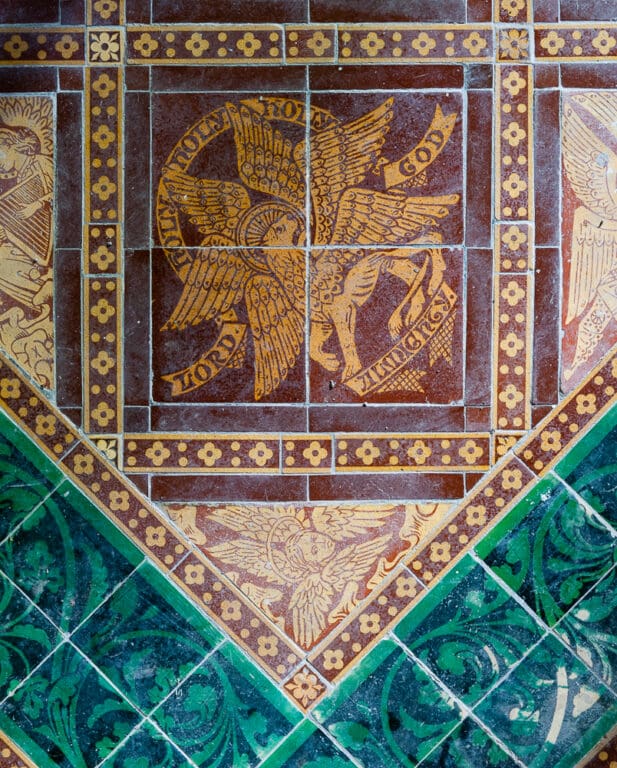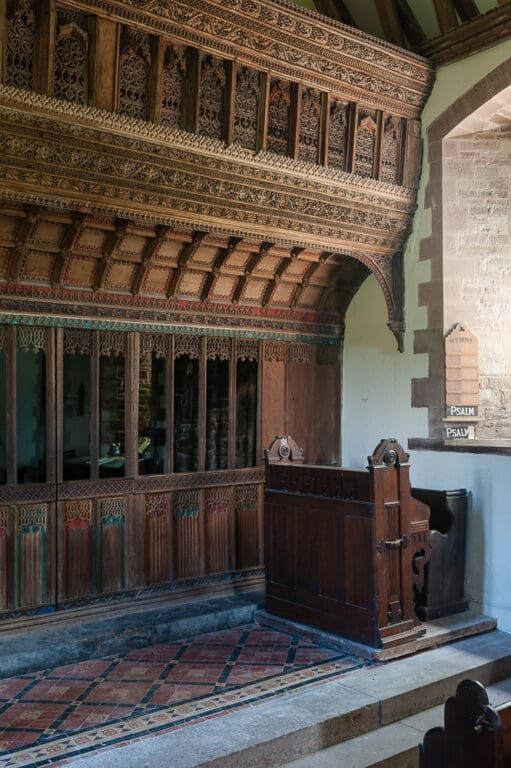
Open daily
OS grid reference
SO 433 006
what3words
supposing.slipped.saloonsPlease note: most SatNavs will take you to a small church in the centre of the village. This is St Isaf’s and it is permanently padlocked shut. This is not our church. Ours is St Jerome’s. Follow the road east till you get to a dead end. St Jerome’s is down a steep flight of steps. Enter through the west door at the end of the path.
These symbols allude to the marriage of Prince Arthur and Catherine of Aragon in 1501.
St Jerome’s in Llangwm Uchaf (upper Llangwm) is a 12th-century church built of Old Red Sandstone, with many remarkable Tudor and Victorian decorative fittings.
The late 15th-century screen at St Jerome’s is one of the finest in Southern Wales. It fills the entrance to the sanctuary and, as Richard Wheeler puts it, in his book on ‘The Medieval Church Screens of the Southern Marches’ it is ‘superabundantly encrusted with carved decoration’. The carving flows with fleshy vines, tight tendrils, plump pomegranates and mythical beasts, while tidy linen-fold panels form the bottom row. The traces of colour (green, red and blue ) come from delicate repairs in the 19th century but are based on medieval precedent. A painted figure of Christ, on the chancel arch above, was visible in 1877 but has now gone – and the carved crucifix, or rood, which would have surmounted the centre of the screen was no doubt a victim of the Reformation. The rood-loft – the walkway in line with the window heads – is intricately carved, and was once accessed by the spiral staircase in the tower.
To illuminate this glorious screen, a square-headed window was installed in the south nave wall in around 1500. Look out for the rose and the pomegranate — an allusion to the marriage of Prince Arthur to Catherine of Aragon in 1501.
Between 1655 and 1659 the rector at Llangwm was the Puritan Divine, Rev William Cradock. He was a moderate and peace-loving man who would come to prominence in the religious, social and political turmoil of the English Civil Wars and Oliver Cromwell’s Commonwealth and Protectorate. Cradock preached the celebratory sermon in Parliament on the fall of Charles 1’s headquarters in Oxford in 1646. He is buried beneath the chancel. Work to dig a drain in recent years uncovered the gravestone of Elizabeth Gwyn, a relation of Cradock, who was murdered in her home in 1743.
Restoration to the church was carried out by Rev William Price between 1863 and 1878 and supervised by J.P. Seddon. who brought fresh colour to many weary country churches. Seddon himself designed the floor tiles, and William Godwin at Lugwardine in Herefordshire produced them. Inspired by imagery from the Revelation of St John the Divine, Seddon created a repeat pattern of angels bearing scrolls inscribed ‘power, riches, wisdom, strength’; the sevenfold gifts of the Spirit three lamps denoting the Holy Trinity; and presbyters, with the scrolls. Before the altar is a representation of the Agnus Dei. In the chancel, green tiles form a striking patriarchal cross, stretching the full length from screen to sanctuary steps. One literally ‘walks the way of the cross’ en route to the communion rails. An outstanding piece of symbolism.
The East Window of c.1877 showing The Annunciation is also by Seddon but from a cartoon by H.A. Kennedy. John Newman, in the Pevsner guide for the county, refers to ‘the nervous intensity of the figures, their Pre-Raphaelite style and the unusual colouring in turquoise and brown’ which ‘make this an exceptional creation’.
On your visit do also look out for the three carved faces sprouting foliage from their mouths. These enigmatic figures inspired Lady Raglan to coin the term ‘Green Man’ in her seminal article for The Folklore Journal, 1939.




The buttons below link to church or local information on other websites.